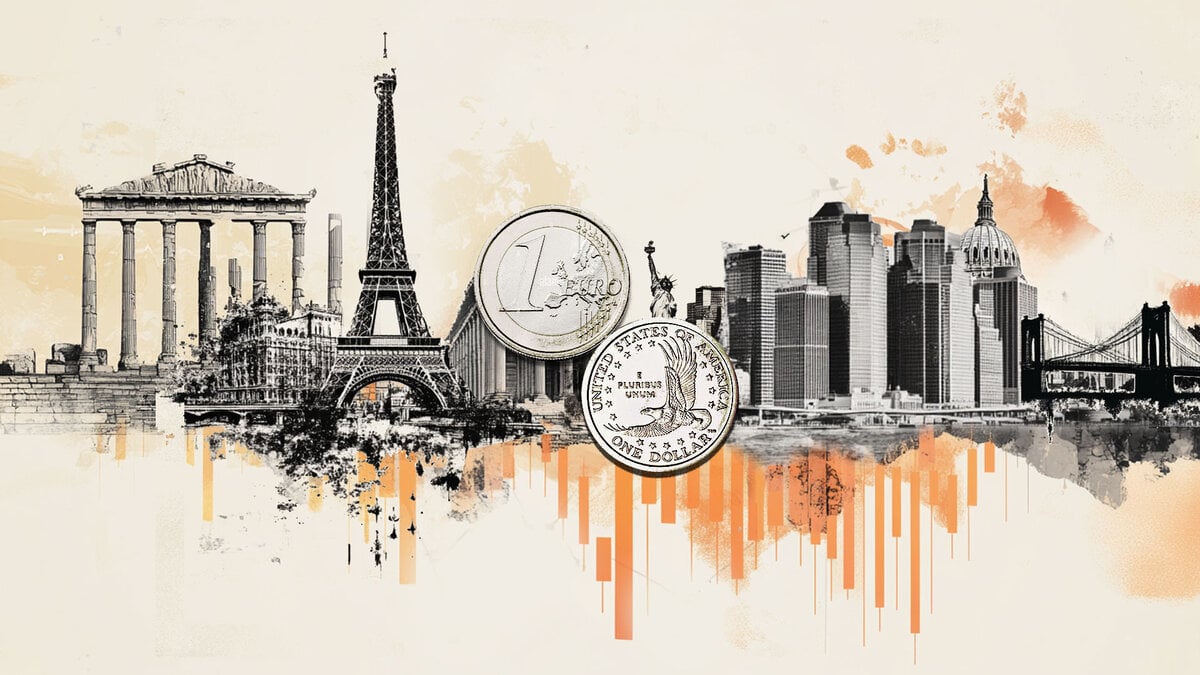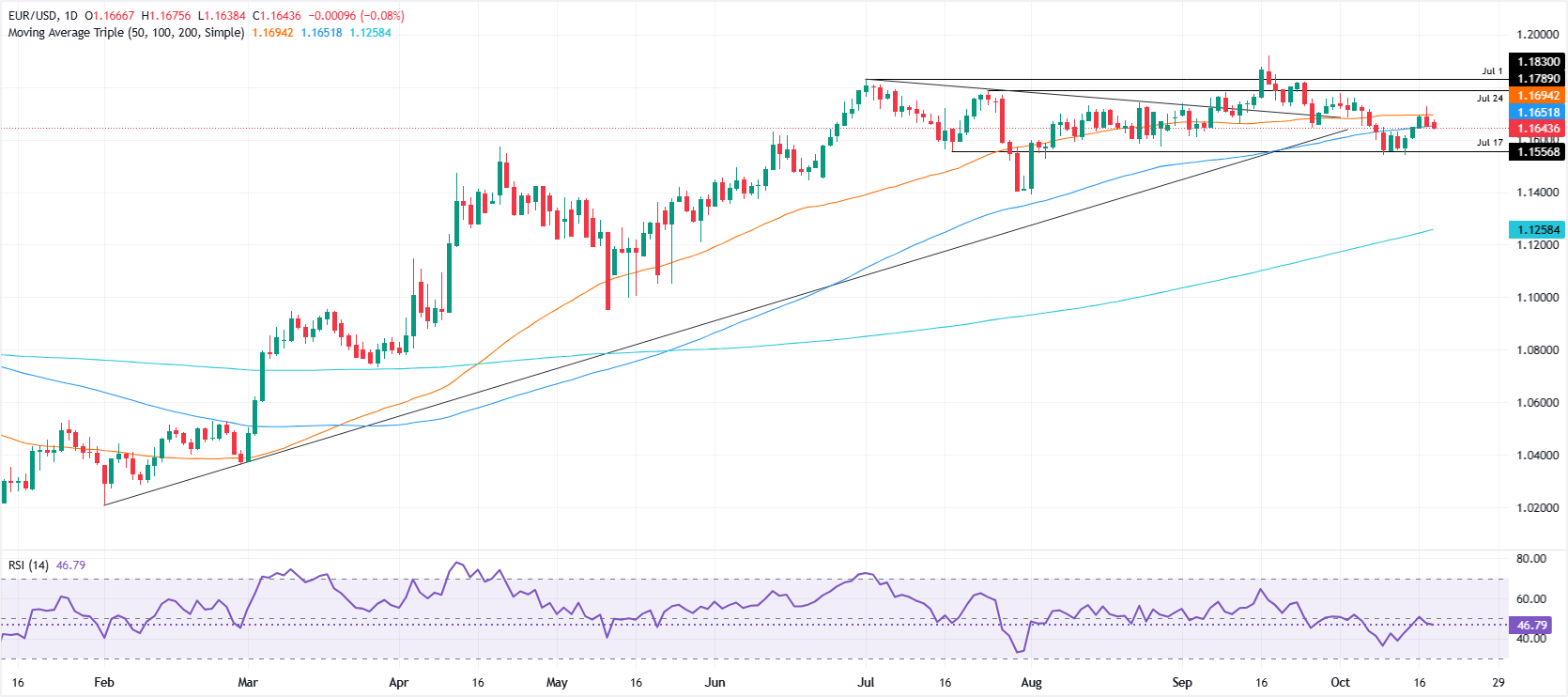Created
: 2025.10.21














![]() 2025.10.21 06:01
2025.10.21 06:01
EUR/USD is virtually unchanged during Monday's North American session, slightly down 0.05% at around 1.1643 after hitting a daily high of 1.1675 amid a scarce economic docket in the US.
The US government shutdown extended for the twentieth consecutive day, leaving investors questioning about the economy's status, as they await the latest Consumer Price Index (CPI) report to be released on Friday. Last Saturday, Federal Reserve (Fed) officials began their blackout period, which will end on October 29, once the central bank released its monetary policy statement, followed by Fed Chair Jerome Powell press conference.
Consequently, market players will remain focused on US domestic politics and US President Donald Trump social media posts. Earlier, Trump said that he could threaten China on other things, including airplanes, and added that he will go to China sometime early next year.
In Europe, officials of the European Central Bank (ECB) crossed the wires. Bundesbank President Joachim Nagel said that they can remain in wait-and-see mode on rates. Earlier, ECB's member Isabel Schnabel said that the Euro's global position is strong and should be strengthened.
During the European session, the Producer Price Index (PPI) in Germany was softer than expected for the third straight month in September. The EUR/USD reaction was muted to the data.
Ahead this week, the Eurozone docket will feature speeches by ECB's member Lane, Escriva, the President Christine Lagarde and Kocher. Across the pond, traders will be leaning on Trump's trade comments and news about the re-opening of the US government.
The table below shows the percentage change of Euro (EUR) against listed major currencies today. Euro was the strongest against the British Pound.
| USD | EUR | GBP | JPY | CAD | AUD | NZD | CHF | |
|---|---|---|---|---|---|---|---|---|
| USD | 0.08% | 0.16% | 0.08% | 0.12% | -0.26% | -0.30% | -0.15% | |
| EUR | -0.08% | 0.08% | -0.04% | 0.03% | -0.33% | -0.40% | -0.23% | |
| GBP | -0.16% | -0.08% | -0.10% | -0.05% | -0.42% | -0.47% | -0.30% | |
| JPY | -0.08% | 0.04% | 0.10% | 0.05% | -0.32% | -0.43% | -0.23% | |
| CAD | -0.12% | -0.03% | 0.05% | -0.05% | -0.31% | -0.42% | -0.26% | |
| AUD | 0.26% | 0.33% | 0.42% | 0.32% | 0.31% | -0.07% | 0.11% | |
| NZD | 0.30% | 0.40% | 0.47% | 0.43% | 0.42% | 0.07% | 0.17% | |
| CHF | 0.15% | 0.23% | 0.30% | 0.23% | 0.26% | -0.11% | -0.17% |
The heat map shows percentage changes of major currencies against each other. The base currency is picked from the left column, while the quote currency is picked from the top row. For example, if you pick the Euro from the left column and move along the horizontal line to the US Dollar, the percentage change displayed in the box will represent EUR (base)/USD (quote).
EUR/USD's technical picture suggests the pair is neutral to bearish biased, capped on the upside by the 100-day Simple Moving Average (SMA) at 1.1650, the 20-day SMA at 1.1677 and by the 50-day SMA at 1.1692.
The Relative Strength Index (RSI) remains bearish, an indication that further downside is seen.
Key support sits at 1.1600, followed by 1.1550 and 1.1500. A decisive break below these levels would expose the August 1 cycle low near 1.1391. Conversely, if buyers clear the 50-, 20- and 100-day SMAs, the next resistance is seen at 1.1700. A breach of the latter will expose 1.1800 and July 1 high at 1.1830.

The Euro is the currency for the 19 European Union countries that belong to the Eurozone. It is the second most heavily traded currency in the world behind the US Dollar. In 2022, it accounted for 31% of all foreign exchange transactions, with an average daily turnover of over $2.2 trillion a day. EUR/USD is the most heavily traded currency pair in the world, accounting for an estimated 30% off all transactions, followed by EUR/JPY (4%), EUR/GBP (3%) and EUR/AUD (2%).
The European Central Bank (ECB) in Frankfurt, Germany, is the reserve bank for the Eurozone. The ECB sets interest rates and manages monetary policy. The ECB's primary mandate is to maintain price stability, which means either controlling inflation or stimulating growth. Its primary tool is the raising or lowering of interest rates. Relatively high interest rates - or the expectation of higher rates - will usually benefit the Euro and vice versa. The ECB Governing Council makes monetary policy decisions at meetings held eight times a year. Decisions are made by heads of the Eurozone national banks and six permanent members, including the President of the ECB, Christine Lagarde.
Eurozone inflation data, measured by the Harmonized Index of Consumer Prices (HICP), is an important econometric for the Euro. If inflation rises more than expected, especially if above the ECB's 2% target, it obliges the ECB to raise interest rates to bring it back under control. Relatively high interest rates compared to its counterparts will usually benefit the Euro, as it makes the region more attractive as a place for global investors to park their money.
Data releases gauge the health of the economy and can impact on the Euro. Indicators such as GDP, Manufacturing and Services PMIs, employment, and consumer sentiment surveys can all influence the direction of the single currency. A strong economy is good for the Euro. Not only does it attract more foreign investment but it may encourage the ECB to put up interest rates, which will directly strengthen the Euro. Otherwise, if economic data is weak, the Euro is likely to fall. Economic data for the four largest economies in the euro area (Germany, France, Italy and Spain) are especially significant, as they account for 75% of the Eurozone's economy.
Another significant data release for the Euro is the Trade Balance. This indicator measures the difference between what a country earns from its exports and what it spends on imports over a given period. If a country produces highly sought after exports then its currency will gain in value purely from the extra demand created from foreign buyers seeking to purchase these goods. Therefore, a positive net Trade Balance strengthens a currency and vice versa for a negative balance.
![]()
Created
: 2025.10.21
![]()
Last updated
: 2025.10.21

FXStreet is a forex information website, delivering market analysis and news articles 24/7.
It features a number of articles contributed by well-known analysts, in addition to the ones by its editorial team.
Founded in 2000 by Francesc Riverola, a Spanish economist, it has grown to become a world-renowned information website.
We hope you find this article useful. Any comments or suggestions will be greatly appreciated.
We are also looking for writers with extensive experience in forex and crypto to join us.
please contact us at [email protected].
Disclaimer:
All information and content provided on this website is provided for informational purposes only and is not intended to solicit any investment. Although all efforts are made in order to ensure that the information is correct, no guarantee is provided for the accuracy of any content on this website. Any decision made shall be the responsibility of the investor and Myforex does not take any responsibility whatsoever regarding the use of any information provided herein.
The content provided on this website belongs to Myforex and, where stated, the relevant licensors. All rights are reserved by Myforex and the relevant licensors, and no content of this website, whether in full or in part, shall be copied or displayed elsewhere without the explicit written permission of the relevant copyright holder. If you wish to use any part of the content provided on this website, please ensure that you contact Myforex.
Myforex uses cookies to improve the convenience and functionality of this website. This website may include cookies not only by us but also by third parties (advertisers, log analysts, etc.) for the purpose of tracking the activities of users. Cookie policy